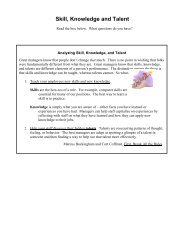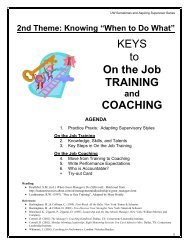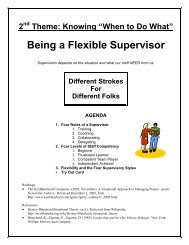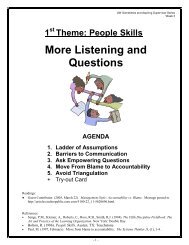Introduction to Integral Theory and Practice IOS Basic and the AQAL ...
Introduction to Integral Theory and Practice IOS Basic and the AQAL ...
Introduction to Integral Theory and Practice IOS Basic and the AQAL ...
You also want an ePaper? Increase the reach of your titles
YUMPU automatically turns print PDFs into web optimized ePapers that Google loves.
deliver treatment, you will die. That is not a separate issue; it is central <strong>to</strong> <strong>the</strong><br />
issue, because all occasions have four quadrants. The Lower-Right quadrant<br />
includes fac<strong>to</strong>rs such as economics, insurance, social delivery systems, <strong>and</strong> even<br />
things as simple as how a hospital room is physically laid out (does it allow ease<br />
of movement, access <strong>to</strong> visi<strong>to</strong>rs, etc.)—not <strong>to</strong> mention items like environmental<br />
<strong>to</strong>xins.<br />
The forgoing items refer <strong>to</strong> <strong>the</strong> “all-quadrant” aspect of <strong>the</strong> cause <strong>and</strong><br />
management of illness. The “all-level” part refers <strong>to</strong> <strong>the</strong> fact that individuals<br />
have—at least—physical, emotional, mental, <strong>and</strong> spiritual levels in each of those<br />
quadrants (see fig. 6). Some illnesses have largely physical causes <strong>and</strong> physical<br />
cures (get hit by a bus, break your leg). But most illnesses have causes <strong>and</strong><br />
cures that include emotional, mental, <strong>and</strong> spiritual components. Literally hundreds<br />
of researchers from around <strong>the</strong> world have added immeasurably <strong>to</strong> our<br />
underst<strong>and</strong>ing of <strong>the</strong> “multi-level” nature of disease <strong>and</strong> cure (including invaluable<br />
additions from <strong>the</strong> great wisdom traditions, shamanic <strong>to</strong> Tibetan). The point is<br />
simply that by adding <strong>the</strong>se levels <strong>to</strong> <strong>the</strong> quadrants, a much more<br />
comprehensive—<strong>and</strong> effective—medical model begins <strong>to</strong> emerge.<br />
In short, a truly effective <strong>and</strong> comprehensive medical plan would be allquadrant,<br />
all-level: <strong>the</strong> idea is simply that each quadrant or dimension (fig. 3)—I,<br />
we, <strong>and</strong> it—has physical, emotional, mental, <strong>and</strong> spiritual levels or waves (fig. 6),<br />
<strong>and</strong> a truly integral treatment would take all of <strong>the</strong>se realities in<strong>to</strong> account. Not<br />
only is this type of integral treatment more effective, it is for that reason more costefficient—which<br />
is why even organizational medicine is looking at it more closely.<br />
<strong>Integral</strong> Business<br />
Applications of <strong>the</strong> <strong>Integral</strong> Model have recently exploded in business,<br />
perhaps, again, because <strong>the</strong> applications are so immediate <strong>and</strong> obvious. The<br />
quadrants give <strong>the</strong> four “environments” or dimensions in which a product must<br />
<strong>Introduction</strong> <strong>to</strong> <strong>Integral</strong> <strong>Theory</strong> <strong>and</strong> <strong>Practice</strong>. Page 36

















